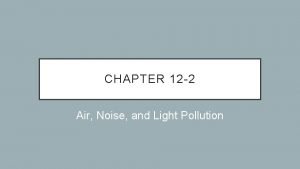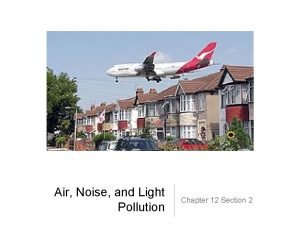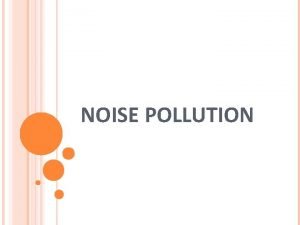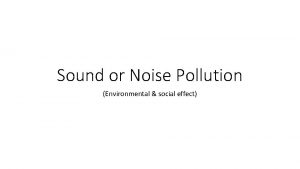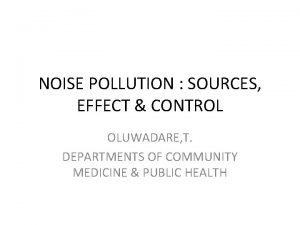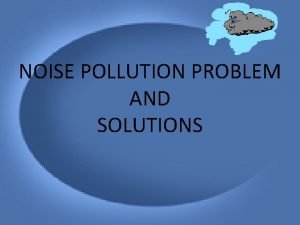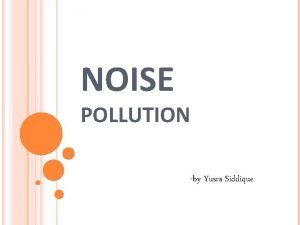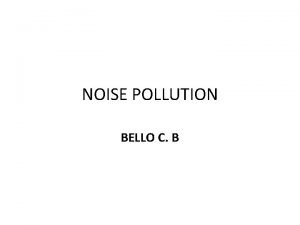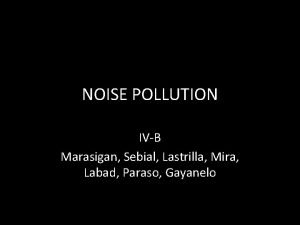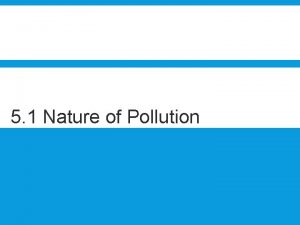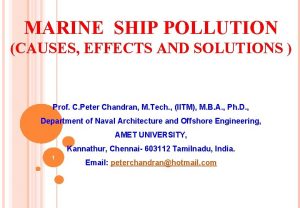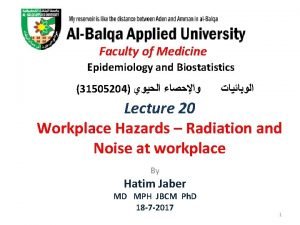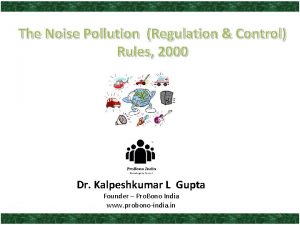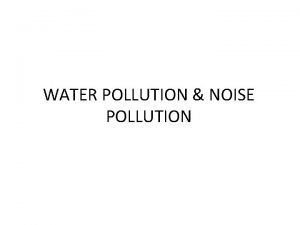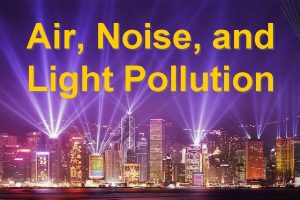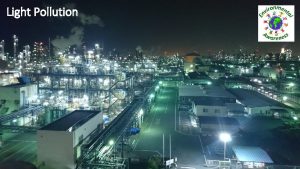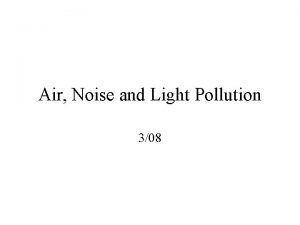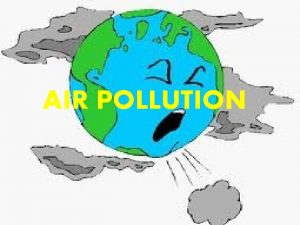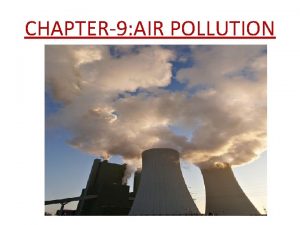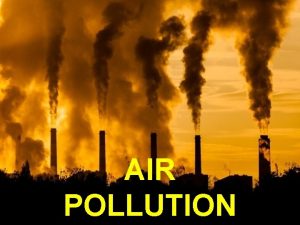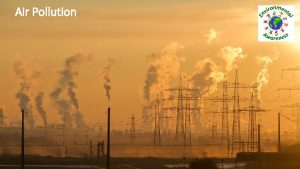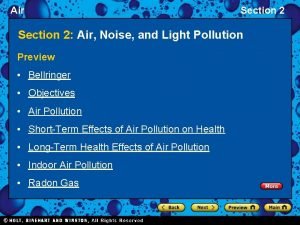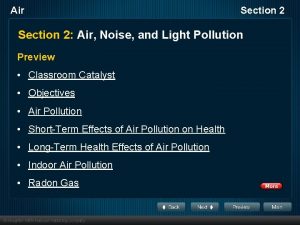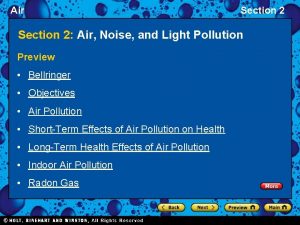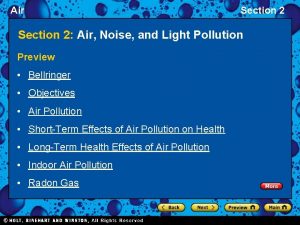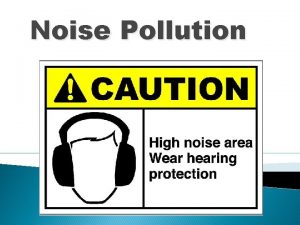Air Section 2 Air Noise and Light Pollution




















- Slides: 20

Air Section 2: Air, Noise, and Light Pollution Preview • Classroom Catalyst • Objectives • Air Pollution • Short-Term Effects of Air Pollution on Health • Long-Term Health Effects of Air Pollution • Indoor Air Pollution • Radon Gas

Air Section 2: Air, Noise, and Light Pollution Preview, continued • Asbestos • Noise Pollution • Light Pollution

Air Classroom Catalyst Section 2

Air Section 2 Objectives • Describe three possible short-term effects and long-term effects of air pollution on human health. • Explain what causes indoor air pollution and how it can be prevented. • Describe three human health problems caused by noise pollution. • Describe solutions to energy waste caused by light pollution.

Air Section 2 Air Pollution • Air pollution cause serious health problems, especially for people who are very young, very old, or who have heart or lung problems. • Air pollution adds to the effects of existing diseases such as emphysema, heart disease, and lung cancer.

Air Section 2 Short-Term Effects of Air Pollution on Health • Many of the effects of air pollution on people’s health are short-term and reversible if their exposure to air pollution decreases. • The short-term effects of air pollution on people’s health include headache; nausea; irritation to the eyes, nose and throat; coughing; tightness in the chest; and upper respiratory infections, such as bronchitis and pneumonia. • Pollution can also make the conditions of asthma and emphysema worse for certain individuals.

Air Section 2 Long-Term Health Effects of Air Pollution • Long-term effects on health that have been linked to air pollution include emphysema, lung cancer, and heart disease. • Long-term exposure to air pollution may worsen medical conditions suffered by older people and may damage the lungs of children.

Air Section 2 Indoor Air Pollution • The quality of air inside a home or building is sometimes worse than the quality of air outside. • Plastics and other industrial chemicals are major sources of pollution. • These compounds can be found in carpets, building materials, paints, and furniture, particularly when these items are new.

Air Indoor Air Pollution Section 2

Air Section 2 Indoor Air Pollution • Sick-building syndrome is a set of symptoms, such as headache, fatigue, eye irritation, and dizziness, that may affect workers in modern, airtight office buildings. • Sick-building syndrome is believed to be caused by indoor air pollutants. • Sick-building syndrome is most common in hot places where buildings are tightly sealed to keep out the heat.

Air Section 2 Indoor Air Pollution • Identifying and removing the sources of indoor air pollution is the most effective way to maintain good indoor quality. • Ventilation, or mixing outdoor air with indoor air, is also necessary for good air quality. • When activities such as renovation and painting, which cause indoor air pollution, are undertaken, ventilation should be increased.

Air Section 2 Radon Gas • Radon gas is colorless, tasteless, odorless, and radioactive. • Radon is one of the elements produced by the decay of uranium, a radioactive element that occurs naturally in the Earth’s crust. • Radon can seep through cracks and holes in foundations into homes, offices, and schools, where it adheres to dust particles.

Air Section 2 Radon Gas • When people inhale the dust, radon enters their lungs. In the lungs, radon can destroy the genetic material in cells that line the air passages. • Such damage can lead to cancer, especially among people who smoke. • Radon is the second-leading cause of lung cancer in the United States.

Air Section 2 Asbestos • Asbestos is any of six silicate minerals that form bundles of minute fibers that are heat resistant, flexible, and durable. • Asbestos is primarily uses as an insulator and as a fire retardant, and it was used extensively in building materials. • However, for all of its uses, the government banned the use of most asbestos products in the early 1970 s.

Air Section 2 Asbestos • That was because exposure to asbestos in the air is very dangerous. • Asbestos fibers can cut and scar the lungs, causing the disease asbestosis. • Victims of the disease have more and more difficulty breathing and may eventually die of heart failure.

Air Section 2 Noise Pollution • A sound of any kind is called a noise. However, some noises are unnecessary and can cause noise pollution. • Health problems that can be caused by noise pollution include loss of hearing, high blood pressure, and stress. • Noise can also have a negative impact on organisms on land in the ocean. Loud sounds have caused whales and dolphins to become stranded on beaches.

Air Section 2 Noise Pollution • A decibel is the most common unit used to measure loudness, and is abbreviated d. B. • The quietest sound that a human ear can hear is represented by 0 d. B. For each increase in decibel intensity, the decibel level is 10 times higher than the previous level. • A sound of 120 d. B is at the threshold of pain. Permanent deafness may come as a result of continuous exposure to sounds over 120 d. B.

Air Noise Pollution Section 2

Air Section 2 Light Pollution • Research suggests that light pollution can increase headaches, fatigue, stress, and anxiety in humans. • Light pollution also negatively affects our environment. • The use of inefficient lighting in urban areas is diminishing our view of the night sky. • In urban areas, the sky is often much brighter than the natural sky.

Air Section 2 Light Pollution • An important environmental concern of inefficient lighting is energy waste. Energy is wasted when a light is directed upward into the night sky and lost to space. Examples include lighting on billboards, poor-quality street lights, and the lighting of building exteriors. • Solutions to this problem include shielding light so it is directed downward, using time controls so that light is used only when needed, and using low-pressure sodium sources, which are the most energy-efficient sources of light.
 Section 2 air noise and light pollution
Section 2 air noise and light pollution Section 2 air noise and light pollution
Section 2 air noise and light pollution Chapter 12 section 1 what causes air pollution
Chapter 12 section 1 what causes air pollution Chapter 12 air section 1 what causes air pollution
Chapter 12 air section 1 what causes air pollution Solution of noise pollution
Solution of noise pollution Companding quantization
Companding quantization Light light light chapter 23
Light light light chapter 23 Light light light chapter 22
Light light light chapter 22 Chapter 22
Chapter 22 About noise pollution
About noise pollution Noise pollution introduction
Noise pollution introduction Sound pollution problems
Sound pollution problems Effects of noise pollution
Effects of noise pollution Noise pollution introduction
Noise pollution introduction 8 effects of water pollution
8 effects of water pollution Noise pollution control
Noise pollution control Noise pollution definition
Noise pollution definition Pollution causes effects and solutions
Pollution causes effects and solutions Solution of noise pollution
Solution of noise pollution Noise pollution act
Noise pollution act Example of noise pollution
Example of noise pollution
